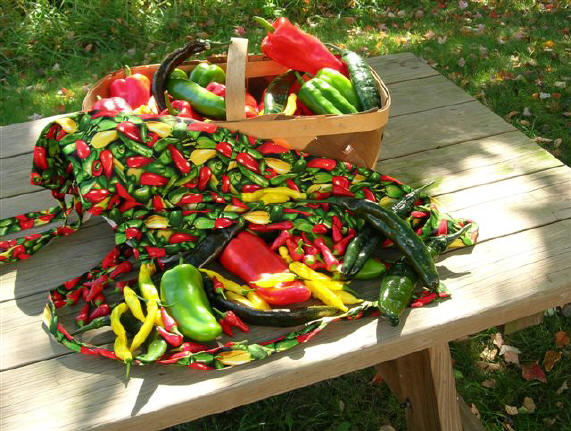|
Pepper Garden - Take 2
Phil Peters
Adams Count Master Gardener
 A Walk on the Wild Side is the theme of this year’s pepper plot in the Adams County Master Gardeners’ display gardens. Visitors can see first-hand a broad gamut of peppers. Their heat ranges from very mild or sweet, to
blazingly hot. They cover the Scoville Heat Scale from zero units to 450,000 Scoville units. A Walk on the Wild Side is the theme of this year’s pepper plot in the Adams County Master Gardeners’ display gardens. Visitors can see first-hand a broad gamut of peppers. Their heat ranges from very mild or sweet, to
blazingly hot. They cover the Scoville Heat Scale from zero units to 450,000 Scoville units.
All the plants on display produce edible fruit, though some, such as ‘Black Pearl’ and ‘Sangria’, are raised primarily for ornamental purposes. ‘Black Pearl’ has been a real eye-catcher for the past few years. Dark leaves are the background for round, marble-sized peppers that display a range of
colors from the beautiful purple blossom to ebony and, then, deep crimson of the mature fruit. These peppers are fiery hot.

‘Sangria’ is a delightful little pepper. The white, six-petalled blossoms give way to finger-like peppers 1"-2" long that give the small, foot tall plants a Christmas tree appearance. The fact that the fruit changes from white to red to purple adds to the effect. This is a very mild pepper even
though it looks like a fire cracker.
On the more conventional side Costa Rica Sweet is an exceedingly mild, larger pepper, in the bell pepper category. Peppers ripen to a brilliant red, with fruit so sweet they can be eaten right off the plant.
Having raised this variety before, I can highly recommend it. It is one pepper I want year after year. The fruit is about 5" long and 3" in diameter when ripe. It can be picked while green or later when red. Either way it has plenty of sweetness and imparts a nice peppery flavor to food. Parboiled
and frozen they will hold through the entire winter.
‘Salsa Delight’ is also a mild pepper. The long slender fruit looks a lot like a cayenne, but without the heat. They will grow to 7" long and give a mild tang to your salsa. The plant is tall and seems leggy and top-heavy. Try pinching out some of the flowers early on to get greater production.
Moving up the heat scale, JalapeZo M gives more of a nip, weighing in at 4,700 Scoville Units. The plant grows about two feet tall and produces 3 ½" fruit. Green at first, they may be picked then or you can wait until they turn red. However, it is best to
pick these when they are still dark green and firm. Cut into rings, they will spice up your salsa. Fully ripened jalapeZos are often smoked several days to remove the moisture. Then they are marketed as chipotles.
‘Thai Hot’ straddles the fence. Its small one inch fruits stand up like brightly colored Christmas lights and call attention to this as an ornamental. It really stands out in a colorful pot on the deck or patio. Added to your cooking, the 8,000 to 12,000 Scoville Unit fruit will surely get your
attention and may cause you to reach for the bread or the milk.
The three plants at the far end of the garden are for the truly dedicated, the real macho pepper heads. ‘Caribbean Red’ is a true habaZero, and a real heavy-weight at that. While many habaZeros measure 100,000 to
350,000 Scoville Units, this baby tops the chart at 450,000 Scoville Units! Needless to say, these plants and peppers should NOT be handled at any time with the bare hands. I recommend wearing rubber gloves and eye protection whenever handling fruit this hot, whether picking in the field or preparing in the kitchen.
We’ve mentioned Scoville Units. These are a measure of heat in peppers. The scale, developed by chemist Wilbur Scoville in 1912, ranges from zero Scoville Units for the bell pepper to 16,000,000 Scoville Units for pure capsaicin, the component that gives the pepper its heat. One drop of heat diluted
by one million drops of water equal 1.5 Scoville Units. Tabasco peppers rate 30,000 – 50,000 Scoville Units. The pepper spray used by police departments is over 5,000,000 Scoville Units.
Capsaicin is concentrated in the seeds and the ribs of the pepper. Removing these will remove a lot, but not all, of the heat. Peppers measuring in the range over 100,000 Scoville Units (Scotch Bonnet) are exceedingly fiery and should be handled with great respect.
Should you get food that is too hot, overcome the heat by drinking milk or eating bread. Hence, the use of sour cream to tone down your Buffalo Wings or chili. Water, and especially alcohol, i.e., beer, will just cause the capsaicin to spread in your mouth and, not only prolong, but increase your
agony by spreading the oil further. Adding sugar to a peppery dish will also bring down the heat.
Read other articles on growing herbs or vegetables
Read other articles by Phillip Peters |